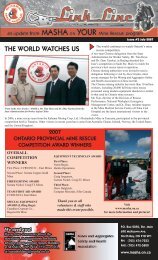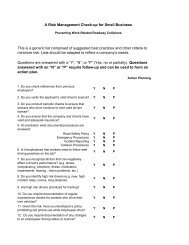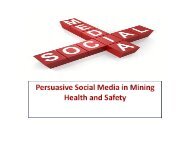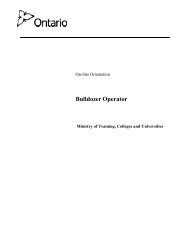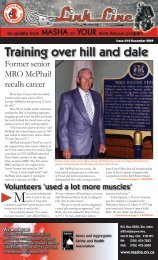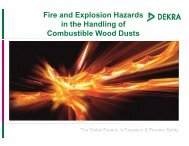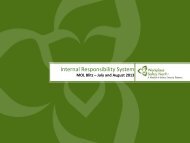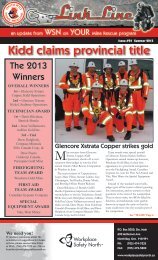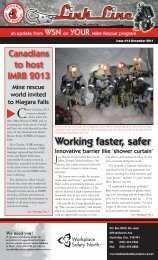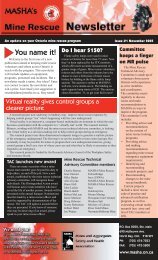EVERY WORKER
Download Every Worker/Winter 2013 - Workplace Safety North
Download Every Worker/Winter 2013 - Workplace Safety North
- No tags were found...
You also want an ePaper? Increase the reach of your titles
YUMPU automatically turns print PDFs into web optimized ePapers that Google loves.
PREVENTING FALLS<br />
FROM EQUIPMENT<br />
If workers stopped jumping off mobile<br />
equipment, there would be a drop of about<br />
five per cent in the number of lost-time<br />
injuries due to falls from mobile equipment<br />
among Workplace Safety North clients.<br />
That’s not a bad start to reducing claims, but it’s not<br />
nearly enough to reduce or stop the pain and suffering<br />
workers experience when injured in falls from mobile<br />
equipment, or the costs to employers when valuable<br />
employees are off work for weeks or months at a time.<br />
Though fatal falls from mobile equipment are uncommon<br />
– none have been recorded among WSN clients in the last<br />
10 years – almost all workers experience soft tissue injuries<br />
such as cuts, bruises and abrasions, sprains, strains, and<br />
muscle tears, and a significant number, more than 25 per<br />
cent, suffer serious hard tissue injuries like dislocations<br />
and fractures to their feet, legs, back, neck and head.<br />
In each sector WSN serves – mining, forestry, paper,<br />
printing and converting – workers are injured in falls<br />
from equipment in roughly equal numbers. They are hurt<br />
falling off mobile equipment of every type, from small<br />
forklifts to huge off-road haul trucks. They fall mounting or<br />
dismounting, maintaining or servicing vehicles, checking<br />
or securing loads, and, yes, several times a year because<br />
they jump or don’t use the ladders or steps provided.<br />
Employers should develop and regularly review a<br />
comprehensive fall prevention plan for mobile equipment<br />
that goes beyond worker awareness of fall hazards and<br />
training in appropriate procedures. The plan could begin<br />
by examining fall protection measures other sectors use<br />
and considering whether those measures can be used or<br />
adapted to their own operations.<br />
Those may include fixed horizontal lifelines on mobile<br />
equipment or in service/maintenance facilities that permit<br />
the use of fall restraint or fall arrest; temporary or portable<br />
anchorage systems that can be attached to equipment or<br />
located next to equipment in operational areas; collapsible<br />
or temporary guardrails on equipment, as well as<br />
temporary ladders or access platforms or other devices.<br />
Since it’s not just operators who fall from mobile<br />
equipment while mounting or dismounting, the plan<br />
should review the specific fall hazards each piece of mobile<br />
equipment poses to different workers, such as mechanics<br />
or maintenance staff, who come into contact with the<br />
equipment, and determine what control measures –<br />
additional fall prevention features, modifications, training,<br />
and procedures – may be appropriate.<br />
For example, recently a worker was working in an<br />
underground shop on the top of an LHD (Load-Haul-<br />
Dump). While on his knees, the worker placed a hand<br />
on a rubber wheel fender which flexed under his weight<br />
causing him to fall (See the Mining Hazard Alert on Pg.<br />
11). Prior modifications to the equipment or different<br />
procedures may have prevented the incident.<br />
Of course, it’s better not to have to modify equipment, so<br />
prior to purchasing new mobile equipment it should be<br />
assessed for the risk of falls. Discussions can be held with the<br />
manufacturer or dealer on additional fall prevention features<br />
they may add, or that can be added during commissioning.<br />
Employer concerns about fall prevention features need to<br />
passed along to manufacturers and dealers, so that they<br />
can jump on the fall prevention bandwagon.<br />
When designing or purchasing equipment note:<br />
• Stairs are preferable to vertical steps<br />
• Continuous hand rails are preferable to individual<br />
grab handles<br />
• Mounting steps should be designed not to collect<br />
dirt (mud, snow or ice)<br />
• Anti-slip paint is preferable to tape<br />
• Access points (stairs and handles) should be<br />
painted a different colour so workers know where<br />
to step and what to grab<br />
• As much servicing as possible is done at ground level<br />
• Lighting for access points, especially for equipment<br />
used in low or poor light situations<br />
10 WorkplaceSafetyNorth.ca



